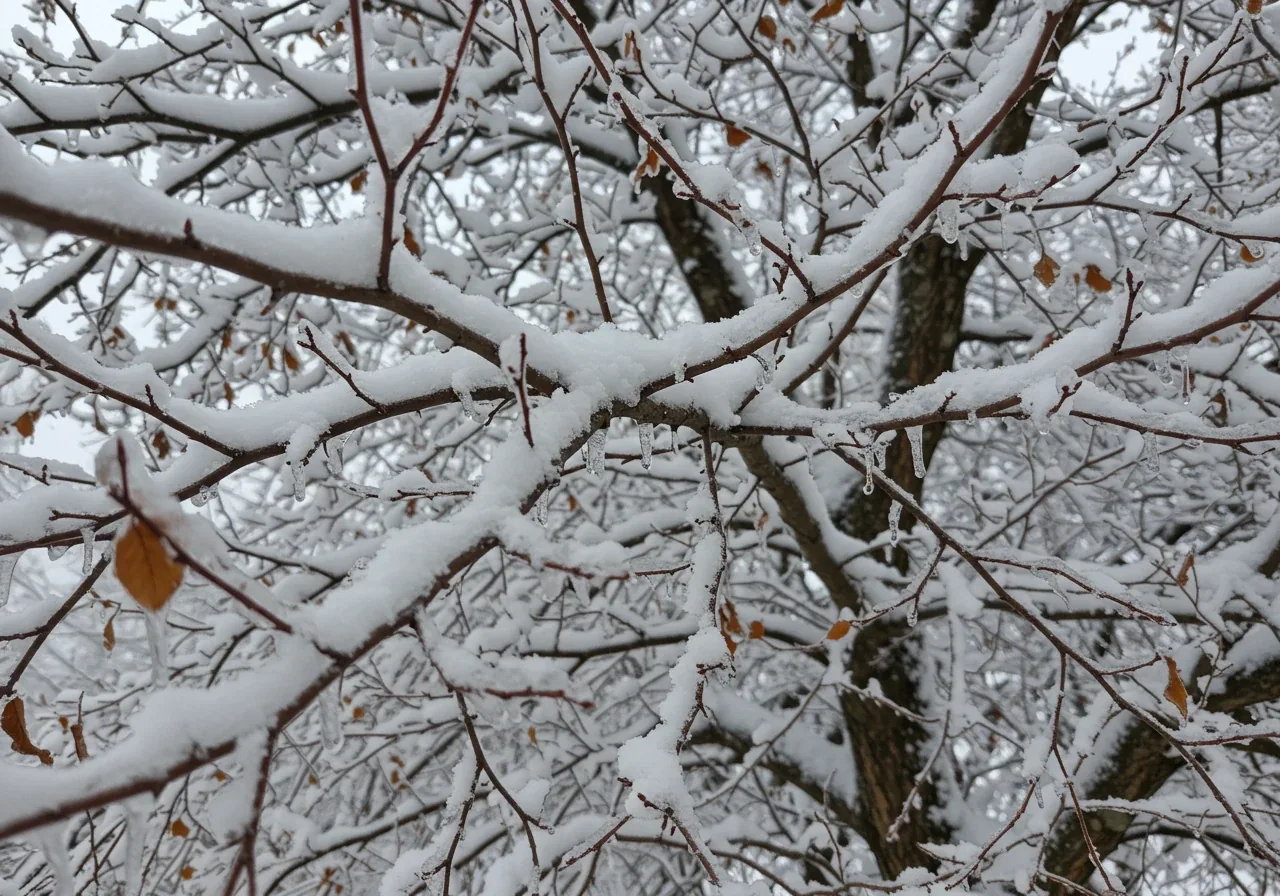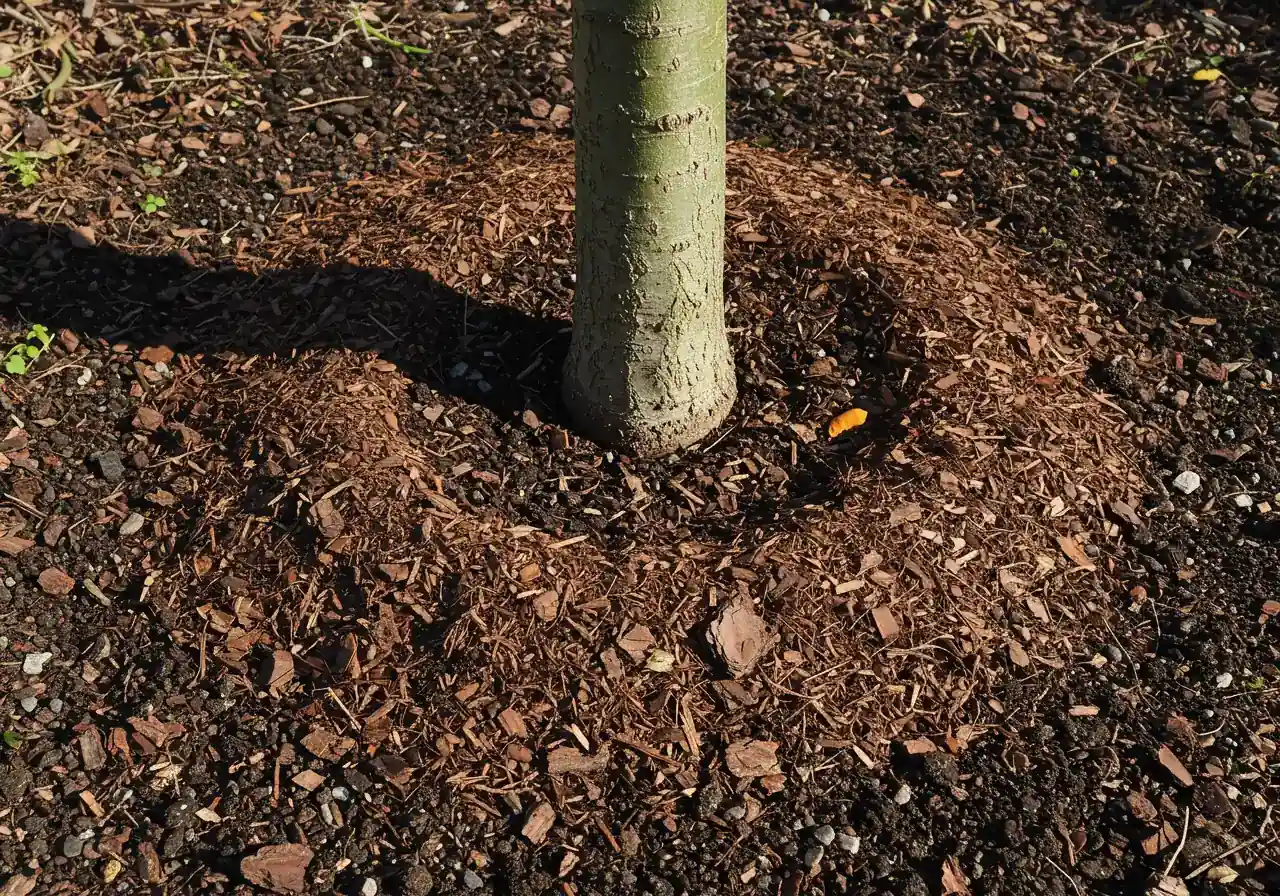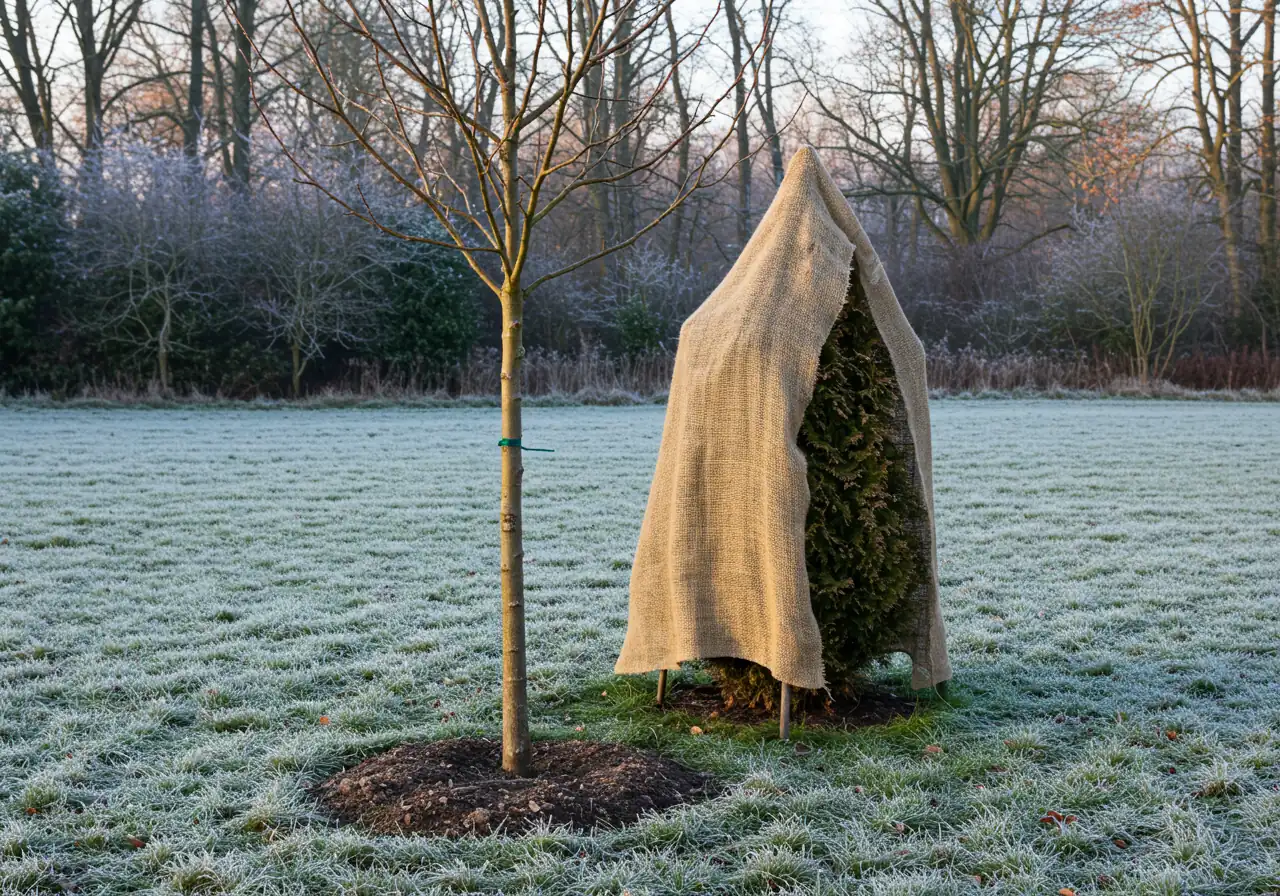Barrhaven Tree Health Check: Prep for Ottawa Winter
Winter is coming to Barrhaven! Ensure your trees are ready to face the Ottawa cold. Need professional help assessing your tree's health or preparing them for winter? Request a free quote today!
Winter Tree Prep Quick Guide:
- Perform a fall health check: inspect base, trunk, and branches.
- Water deeply before the ground freezes, especially evergreens.
- Prune dead, damaged, or diseased branches after leaves fall.
- Apply 2-4 inches of mulch around the base (not touching the trunk).
- Protect young/vulnerable trees with wraps or burlap screens.
Introduction: Brrr-ace Yourselves! Winter is Coming for Barrhaven's Trees
Alright Barrhaven neighbours, let’s chat about winter. No, not just the cozy evenings and potential snow days, but the serious business of keeping our trees happy and healthy when the temperatures plummet. Here in Ottawa, winter isn't messing around – it brings biting winds, piles of heavy snow, and sometimes those infamous ice storms that can really challenge our local landscape.
Your beautiful maple, sturdy oak, or lovely lilac might look tough, but the harsh reality of an Ottawa winter, especially here in Barrhaven, can take its toll. Branches burdened with snow and ice can snap, young trees can suffer bark damage from critters or frost cracks, and evergreens can dry out in the winter wind. Think of winter tree care as essential preventative gardening. A little effort before the deep freeze truly sets in can prevent damage, save you stress, and ensure your trees bounce back beautifully in the spring. So, grab a warm drink, and let’s explore how to give your Barrhaven trees the winter armour they need! You can also check our Google My Business page for more local tips and updates.
Why Ottawa Winters Give Trees the Chills (And How to Help!)

Ever wonder why our Ottawa winters seem determined to give our leafy friends such a hard time? It's not just you feeling the chill! Trees, even the hardy Canadian ones growing in areas like Barrhaven or Greely, face some serious challenges when the temperature plummets and the snow flies. Let's break down what makes our winters so tough on them.
- The Big Freeze: Trees are mostly water. When temperatures dip way below freezing, the water inside their cells can freeze, expand, and cause damage – think of it like microscopic frostbite! They go dormant (like a deep sleep) to survive, shutting down growth. But sudden thaws followed by deep freezes, common in our region, can trick them and cause stress or even frost cracks on their bark. Consistent watering in the fall, before the ground freezes solid, helps them prepare. Remembering Barrhaven Summer Irrigation Tips to Save Water can actually inform good fall watering habits too – ensuring deep moisture penetration before the freeze is key. And speaking of water, don't forget to winterize your sprinklers! If you need help, check out tips on how to Fix Common Sprinkler System Issues in Barrhaven.
- Heavy Lifting (Snow & Ice): Remember those stunning ice storms or days with heaps of wet, heavy snow? While beautiful, that weight puts enormous strain on branches, especially on weaker or poorly structured limbs. Snap! Goes the branch. This is why strategic pruning before winter is so important in landscape management. Removing weak or dead branches reduces the risk of damage. Proper fall cleanup is essential; if you're looking for assistance, consider a Barrhaven Yard Cleanup Service to get your yard ready.
- Wind Burn Woes: Winter winds are drying. They whip away moisture from leaves and needles, especially on evergreens which don't drop their foliage. This "desiccation" is like a plant getting severely dehydrated when it can't easily draw water from the frozen ground. You might see brown, "burnt" looking needles come spring. Useful resources on wind protection can often be found via the City of Ottawa Forestry Services page.
- Tricky Clay Soil: Much of Ottawa, including areas like Barrhaven, has clay soil. While it holds moisture well, it also expands and contracts significantly during freeze-thaw cycles. This can heave shallow-rooted plants right out of the ground or damage delicate roots just below the surface. Learning about local soil types can be beneficial; check resources from Ontario's Ministry of Agriculture, Food and Rural Affairs.
So, what can we do? It’s about giving our trees a fighting chance! Proper fall watering, applying mulch around the base (like a cozy blanket for roots), wrapping younger or sensitive trees, and smart pruning are all key gardening strategies. While you're planning your fall yard work, maybe even consider some Fall Fire Pit Design Tips for Ottawa Yards to enjoy the crisp air before winter fully sets in. Thinking ahead protects your investment and ensures you have beautiful trees to shade your yard when you're dreaming up Creative Barrhaven Patio Design Ideas for Summer. Need a hand with any of these preparations? Explore our comprehensive Landscaping Services for expert help.
Your Barrhaven Backyard CSI: Conducting a Fall Tree Health Check
Okay Barrhaven, grab your detective hat (a toque might be more fitting soon!) because it’s time for some Backyard CSI. Before the snow flies and covers everything up, doing a quick fall health check on your trees is a brilliant move. Think of it as a wellness check-up for your leafy neighbours, ensuring they’re ready to face another tough Ottawa winter. Don't worry, you don't need a magnifying glass, just your eyes and a few minutes.

Your Step-by-Step Tree Investigation:
- Start at the Bottom: Look at the base of the trunk where it meets the ground. Do you see any mushrooms or fungus growing there? That can sometimes signal root rot. Are there any major cracks or wounds? Check the soil – is it compacted or disturbed? Also, clear away fallen leaves and debris from the base. If the autumn leaf drop is overwhelming, remember that a thorough fall tidy-up, perhaps with help from a Barrhaven Yard Cleanup Service, makes inspections easier and discourages pests. Proper soil preparation is also vital for long-term health.
-
Examine the Trunk: Slowly walk around the tree, scanning the trunk from bottom to top. Look for:
- Deep cracks or splits in the bark.
- Holes or sawdust (sometimes indicating insects like the dreaded Emerald Ash Borer, especially in Ash trees - see resources from CFIA).
- Areas where bark is missing or peeling excessively (some shedding is normal for certain trees, like birch).
- Unusual growths or bulges.
-
Look Up! (Carefully): Scan the branches and the overall shape (or canopy) of the tree.
- Are there dead, broken, or dangling branches? These are hazards, especially under snow load.
- Are branches crossing and rubbing against each other? This creates wounds where disease can enter.
- Even though leaves are falling, did you notice unusual leaf discolouration, spots, or early dropping before fall really set in? This could indicate stress or disease from the summer. Proper Garden Maintenance throughout the year helps spot these issues early.
Healthy vs. Unhealthy Signs (Quick Comparison):
| Feature | Healthy Sign | Potential Unhealthy Sign |
|---|---|---|
| Trunk Base | Clear of fungus, solid ground contact | Mushrooms, major cracks, visible root decay |
| Bark | Intact (relative to species), normal color | Deep cracks, large holes, excessive peeling, sawdust trails |
| Branches | Evenly spread, few dead twigs | Many dead/broken branches, crossing/rubbing limbs |
| Overall Structure | Strong central leader (usually), balanced canopy | Sudden lean, large cavities, lopsided growth |
| Leaves (During Season) | Normal color and density for species | Early discoloration, spots, premature drop, sparseness |
What If You Spot Trouble?
Finding a small issue doesn't mean disaster! Minor pruning of dead twigs might be all that's needed. However, if you see major cracks, significant dead branches, signs of serious pests, or anything that makes you nervous, it’s best to call in professionals. Dealing with tree issues is different from routine Lawn Care; it often requires specialized knowledge and equipment from certified arborists or experienced landscapers like those found through our About Us page.
Don't let potential problems fester over winter. A quick fall check-up helps ensure your Barrhaven trees stand tall and healthy for years to come. And remember, good yard hygiene helps everyone – whether you're in Barrhaven, nearby Metcalfe needing a Metcalf Yard Cleanup Service, or even further out like Marionville requiring a Marionville Yard Cleanup Service. Keeping our shared environment healthy is a community effort, extending across the whole City Yard Cleanup Service area.
The Pre-Winter Tree Spa Treatment: Pruning, Watering, and Mulching

Think of late fall as sending your trees off to a relaxing spa before they face the tough bootcamp of an Ottawa winter. This isn't about cucumber water and fluffy robes, though. It’s about three key treatments: a smart haircut (pruning), a deep drink (watering), and a cozy blanket (mulching). Giving your trees this attention now helps them shrug off winter’s worst and burst back with vigour in the spring, whether you're in Nepean, Greely, or right here in Barrhaven.
The Strategic Snip: Pruning
Winter winds and heavy snow love to pick on weak spots. Pruning now is like tidying up potential problems before they cause real damage.
- Why Prune Now? Once deciduous trees lose their leaves (go dormant), it's much easier to see their structure. You're mainly looking for the "Three Ds": Dead, Damaged, or Diseased branches. Removing these prevents them from snapping under snow load and potentially damaging healthy parts of the tree or, worse, property or people. Also, removing branches that cross and rub against each other prevents wounds that invite pests and disease. Think of it as preventative landscape care.
- When? The best time is late fall or early winter, *after* the leaves have dropped and the tree is dormant, but *before* the really harsh freezing temperatures and heavy snows arrive. Usually, late October through November is a good window in Ottawa.
- How?
- Use sharp, clean pruning shears or saws. Clean tools prevent spreading disease – wipe them with rubbing alcohol between cuts if you suspect disease.
- Focus on smaller branches you can safely reach. Remove deadwood back to the nearest healthy branch or the trunk, but don't cut flush against the trunk – leave the slightly raised "branch collar" intact to help healing.
- Safety First! For large branches, anything requiring a ladder, or if you're unsure, *always* call in certified arborists or professional landscaping services like those offered through our Property Clean Up options. It's not worth the risk. This kind of task goes beyond basic Garden Maintenance and requires expertise.
- Eco-Tip: Healthy pruned twigs and branches can be chipped for mulch or composted, reducing waste. Diseased wood should be disposed of properly – check City of Ottawa guidelines. A thorough general Property Clean Up can handle this debris.
The Last Big Gulp: Watering
It sounds odd to water before winter, but it's crucial! Trees, especially evergreens that keep their needles, can dry out badly in freezing winds when the ground is frozen solid and they can't absorb moisture.
- Why Water? Think of it as filling up the tank before a long trip. Adequate moisture in the soil and roots helps trees withstand drying winter conditions (desiccation) and the stress of freezing temperatures. This is particularly important for younger trees and evergreens.
- When? Water deeply in the fall, especially during dry spells, right up until the ground freezes. Pay attention to the weather – if we have a dry October or early November, give your trees a good soak.
- How?
- Water slowly and deeply around the tree's drip line (the area under the outermost branches), not just at the trunk. Aim for the water to soak down at least 8-12 inches. A soaker hose on low for several hours is great.
- For established trees, one or two deep waterings in the fall might be enough if rainfall is decent. Newly planted trees may need more consistent watering. Consider our Garden Install services for advice on new plantings.
- Eco-Tip: Use rainwater collected in barrels if you have them!
The Cozy Blanket: Mulching
Mulch isn't just for summer gardens; it's a winter lifesaver for tree roots.
- Why Mulch? A layer of mulch acts like insulation. It helps regulate soil temperature, protecting roots from the constant freeze-thaw cycles common in Ottawa winters that can heave roots and damage them. It also helps retain that precious moisture you just added and suppresses late-fall weeds. Learn more about the benefits with our Mulching and Edging services.
- When? Apply mulch *after* the ground has cooled down significantly, maybe after the first light frost, but *before* it freezes solid. Applying too early when the ground is warm can keep it too warm, delaying dormancy.
- How?
- Apply a layer of organic mulch (like shredded bark, wood chips, or even shredded leaves from your yard cleanup) 2-4 inches deep around the base of the tree. Extend it out towards the drip line if possible, especially for younger trees.
- Crucially: Keep the mulch a few inches *away* from the actual tree trunk. Piling mulch against the trunk (the dreaded "mulch volcano") invites moisture buildup, pests, and rot right where the tree is vulnerable. Give it space to breathe! Our Material Selection guide can help choose the right mulch.
- Need help sourcing good mulch or handling the overall yard prep? Services ranging from specific areas like a Metcalf Garden Clean Up Service to broader options like a Metcalf Property Cleanup Service can assist. Many professional services, like a comprehensive Marionville Property Cleanup Service, often include mulching. When you contact professionals across the region via a City Garden Maintenance Service, rest assured your details are handled respectfully – you can review our commitment in our Privacy Policy.
- Eco-Tip: Use fallen leaves (shredded with a mower first works best) as a free, natural mulch!
Giving your trees this pre-winter spa treatment sets them up for success. A little pruning, proper watering, and a good layer of mulch go a long way in helping your leafy investments survive and thrive through the Ottawa winter chill.
Pre-Winter Tree Care Timeline (Late Fall):
Step 1: Inspect & Assess
Perform the "Backyard CSI" health check after most leaves have fallen to clearly see structure.
Step 2: Prune (if needed)
Remove dead, damaged, diseased, or rubbing branches while the tree is dormant.
Step 3: Deep Water
Provide a thorough soaking, especially if the fall has been dry, before the ground freezes.
Step 4: Apply Mulch
Once the ground is cool, add a 2-4 inch layer of mulch around the base (away from the trunk).
Step 5: Protect Vulnerables
Wrap young trees or install burlap screens for evergreens just before harsh conditions set in.
Sweater Weather for Trees: Protecting Youngsters and Evergreens

Okay, team, let's talk about the little guys and the year-round green giants in our yards. While our established maples and oaks might just shrug off the cold, young trees and delicate evergreens often need a bit more TLC to get through a classic Ottawa winter. Think of it like giving them a cozy sweater or a windbreaker – essential gardening gear for the cold season!
Why the special treatment? Young trees have thin bark, making them susceptible to sunscald. On bright, sunny winter days, the sun warms up the south or west side of the trunk. Then, when the temperature plummets at night, the rapidly freezing and expanding moisture can cause the bark to split vertically – ouch! The solution? Wrap the trunk with a commercial, light-coloured tree wrap starting from the base and going up to the lowest branches. Remove it in the spring, though, so the bark can breathe!
Evergreens, like cedars, pines, and junipers, face a different battle: winter burn. Since they keep their needles or leaves, they continue losing moisture to dry winter winds and sun, especially when the ground is frozen solid and they can't replenish it. This leads to those ugly brown, dried-out patches. To help, create a wind/sun barrier using burlap screens, particularly on the south and west sides (and the side facing prevailing winds). Stake the burlap a few inches away from the foliage – don't wrap it tightly like a mummy!
Then there are the hungry critters. Rabbits, mice, and voles love to nibble on tender bark during lean winter months, potentially girdling and killing young trees. If you live near green spaces, like some areas around Richmond, deer might also browse on reachable branches. Plastic rodent guards placed around the base of young tree trunks are a simple and effective defence against smaller munchers. Keeping the area around the trees clear of long grass and debris also reduces hiding spots; sometimes a good fall tidy-up is the first line of defence. Consider a professional General Property Clean Up to ensure things are neat before the snow. Even specific areas benefit, like getting help from a Marionville Garden Clean Up Service.
Lastly, let's not forget our old foe: road salt. If your trees are near sidewalks or roads, especially in suburban areas like Barrhaven, salt spray and runoff can seriously damage roots and foliage. Burlap screens can offer some protection from direct spray. Strategic Mulching and Edging can also create a bit of a buffer zone. For future plantings near roads, consider choosing salt-tolerant species when planning your next Garden Install. Taking these protective steps now makes a huge difference. If tackling this seems daunting, remember that expert help is available, whether it's a full Marionville Property Cleanup Service or specific tree care tasks – we’re always happy to assist and offer a big Thank You for letting us help keep your landscape healthy! A little protection goes a long way in ensuring these vulnerable trees greet the spring happy and healthy.
Common Winter Tree Damage Risks in Ottawa
*Relative risk potential; actual risk depends on tree type, location, and specific winter conditions.
Key Insights: Ottawa Winter Tree Care Cheat Sheet
Alright folks, winter in Ottawa isn't always a walk in the park (especially if that park is covered in ice!), but keeping your trees safe doesn't have to be rocket science. Here’s your quick gardening guide to winter tree survival:
- Hydrate Before It's Too Late: Give your trees, especially evergreens and young ones, a final deep watering before the ground freezes solid. Think of it as their last big drink before the ice bar opens.
- Trim the Trouble: Once leaves drop, prune out dead, damaged, or dangerously crossing branches. This prevents nasty breaks under heavy snow or ice. Safety first – leave big jobs to the pros!
- Tuck Them In (With Mulch): Apply a 2-4 inch layer of organic mulch around the base, but not touching the trunk. Proper Mulching and Edging insulates roots from freeze-thaw cycles.
- Sweater Weather: Wrap thin-barked young trees to prevent sunscald and shield evergreens near roads or windy spots with burlap screens. Thoughtful Material Selection makes a difference here.
- Clear the Critter Cafe: Remove fallen leaves and debris from around tree bases to discourage mice and voles from nibbling on bark. A fall cleanup is essential – consider help from an Ottawa Garden Clean Up Service if your yard looks overwhelming.
- Ottawa Timing Tip: Aim to get most of this done by mid-November, before the ground turns into a rock!
Feeling overwhelmed, maybe in Manotick or Nepean, and need a hand with your landscape prep? Don't hesitate to Contact Us. We value your input on how we do, too – feel free to share comments via our Estimate Feedback page!
Barrhaven Tree FAQs: Your Ottawa Winter Worries Answered
Winter throws some curveballs at our precious trees here in Barrhaven and across Ottawa. Got questions? We've got answers! Here are some common winter worries tackled, with tips to keep your leafy pals happy until spring.
Hold your horses on the fertilizer! Generally, no. Fertilizing late in the fall can encourage new growth that won't harden off before the deep freeze, making it vulnerable to damage. Stick to the essentials mentioned earlier, like watering and mulching. Proper gardening timing is key; focus nutrients during the growing season.
First, safety! Stay clear if it's unstable or near power lines (call Hydro Ottawa for line issues). If it's safe, you can carefully remove smaller debris. For large branches or tricky breaks, call a professional tree service. They have the gear and know-how. Afterwards, a general cleanup might be needed; consider looking into a Reliable City Property Cleanup Service to handle the mess, or a more focused Professional City Garden Clean Up Service if it's mainly garden debris. Always review service details, like those found in typical Terms and Conditions, before hiring.
Not necessarily! As long as the ground isn't frozen solid and the trunk is relatively dry, you can still apply tree wrap. The main goal is protecting against sunscald on sunny winter days. It's better late than never, but aim to get it done before the *really* frigid temperatures and heavy snow arrive for optimal landscape protection.
Don't panic just yet! This often looks like winter burn (desiccation). Evergreens can lose moisture in winter winds and look brownish. Wait until spring to see if new growth emerges. Ensure it was well-watered last fall and consider burlap protection *next* year if it’s in an exposed spot. Sometimes, patience (and maybe a little spring TLC) is the best gardening approach.
It can! Heavy clay soil expands and contracts a *lot* during freeze-thaw cycles, which can heave shallow roots or stress the root system. Good fall mulching helps insulate and moderate soil temperature swings. Ensuring good drainage through proper Ottawa Soil Preparation Techniques when planting also helps long-term. This soil type can also impact other landscaping efforts, like needing specific approaches for successful Barrhaven Sod Installation Projects.
It's getting risky! Ideally, trees need time for roots to establish before the ground freezes hard. Planting very late in fall (like November in Ottawa) gives them little time. If you *must* plant late, water it exceptionally well and apply a thick layer of mulch. Otherwise, it's often better to wait until spring for better survival chances. Need help deciding? Contact us!
Conclusion: Give Your Barrhaven Trees a Fighting Chance This Winter!
Well, there you have it! Winter in Ottawa, whether you're in Barrhaven, bustling Nepean, leafy Manotick, or spacious Greely, doesn't have to mean doom and gloom for your trees. Think of this fall prep as a bit of preventative gardening and tree care – like giving your leafy pals a flu shot and a warm coat before the really nasty weather hits. It might seem like one more thing on the fall to-do list, but trust us, it's worth it.
By taking a little time now for that health check, smart pruning, deep watering, cozy mulching, and maybe wrapping the vulnerable ones, you're not just doing chores; you're investing in your landscape. You're helping ensure your trees survive the ice, snow, and wind, preventing costly damage, and setting them up for a spectacular spring comeback. A healthy tree adds beauty and value to your home, after all! See some examples on our Transformations page.
So, what's next? Roll up your sleeves, grab your tools (and maybe a hot chocolate!), and put these tips into action. Give your trees the best shot at weathering the winter storm.
Feeling a bit overwhelmed or short on time? Hey, we get it! If tackling tree prep feels like too much, don't hesitate to reach out. Professional landscaping help is just a click or call away to ensure your Barrhaven trees get the expert care they deserve. Let's make sure your trees are ready to say "Bring it on, winter!" (in their own quiet, leafy way).
Explore more services: Barrhaven Cleanup | Marionville Cleanup | Metcalf Cleanup | City Wide Cleanup | City Garden Cleanup | Metcalf Garden Cleanup | Marionville Garden Cleanup | City Property Cleanup | Metcalf Property Cleanup | Marionville Property Cleanup

